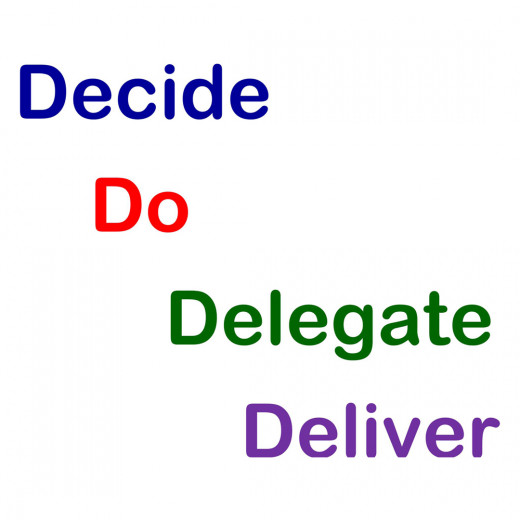How to Run a One-Person Business
Four Dees to Succeed

One-Person Business: Run it, or Run Away?
I've been running my own business since 1993. Most of that time, it has been a one-person operation. At my largest, though, I had a team of four part-time experts working with me.
At the worst, I got burned out and sick, and I found myself hating to do the things that I really love most. And that's the worst feeling in the world. I'm writing honestly here, to help you avoid the mistakes I've made, and to find and manifest success, as I have. That way you can run your business well, instead of wanting to run away from it.
I'm the kind of person who likes to become expert at everything I do. So, I haven't just run a business, I've learned all about how to run a one-person business and written a best-selling book on how to run a small business, The Ultimate Guide to Project Management for Small Business. My project management expertise brings a lot of insight into what makes a one-person business succeed.
I've had a lot of fun learning from my successes, and from my mistakes, as well. I hope you'll enjoy an overview of the crucial factors for success in a one-person business.
By the way, have you heard the latest buzzword? If you run a one-person business, you are a solopreneur.
Key Success Factors for the One-Person Business
Here is a list of the key factors for success in being a solopreneur. The list is important, because 95% of all new businesses fail, and the rate for solopreneurs is even worse. And, even if you stay in business, you can easily burn out if you're not careful. I know - I've been there, and recovered. Please learn from me before you learn from the school of hard knocks!
Some of these subjects are big enough for an article of their own. If the topic interests you, follow the link.
- Keep your business separate from your home life, even if you work at home and manage your time well.
- Reduce your stress. Your stress-free time is your business's biggest asset.
- Define success for your business in a way that includes everyone and creates SMART goals.
- Create all the plans you need to succeed. Planning doesn't take a long time, and it prevents major mistakes and saves tons of time, so you can make a lot more money, faster.
When you've taken care of these basics, you've cleared a path to success. Your personal life won't interfere too much. You'll be relaxed and able to be in the game, doing your best. You'll have a plan - in fact, five plans - so you won't wander around wondering what to do. At that point, you'll be ready to sit down and run your business. That's what this article is all about.
Where is your business today?
Which of these best describes where your business is today?
Work on Your Business, and in Your Business
Working in your business means doing the day-to-day work that brings in customers, delights them, gives them what they want, and brings in the money.
It works for a while, but if all you do is work in your business, you'll be out of business pretty fast. Something will go wrong, and you won't see it coming. Or your competitors will be working on their business, getting better, and you'll be left in the dust.
Working on your business means improving your business. It means solving problems, doing better marketing to get more customers at lower cost, improving products and services, and figuring out ways to work smarter, and making them happen.
If all you do is work on your business, you'll have the best business in the world - and you'll be out of business in no time, because you never got to work and made any money.
The solution is a healthy balance of working in your business to make money and working on your business so you can keep in business and make more money.
Decide, Delegate, Do, Deliver
The way to run your business is to make sure that each week, you do all four of these "Dees":
- Decide. Don't delay decisions. If a problem needs to be solved, solve it. If a person is waiting to hear from you, get in touch. Delaying or avoiding decisions can put you so far behind that you run out of cash before you know it.
- Do. Don't spend all your time planning and thinking. Do whatever the heart of your work is. Do work for clients and get paid. Do marketing and sales, and get new clients. Track your productive work hours in a time sheet, and put in the hours.
- Delegate. Don't do everything yourself. If you're really small, you may do 90% yourself. But have a bookkeeper update your books. Get a techie to do your web site. If you're doing well, invest in an administrative assistant or virtual assistant. And, when working with this person, give them clear instructions and have them work alone. Don't let them interrupt you, and make sure they deliver good results.
- Deliver. Don't spin your wheels. Finish what can be finished, and deliver it. And don't forget to include an invoice!
Let's take a closer look at each of the 4 Dees to Do to run your one-person business, having fun and enjoying the success of making your dreams real.
Decide
Quite simply, the solopreneur who delays key decisions will find himself out of business very fast. No decision is worse than a bad decision. If we make a decision - good or bad - we live with the consequences and move forward. If we don't decide, if we waver and avoid and delay, then the worry about the decision wears us down - whether we know it or not.
Decision-making is a process. That means that it is a logical series of steps. Here's a good decision-making process. Take a break between each step. If the step was a big one - if it took a lot of energy, then get a good night's sleep before the next step.
- Clear your head. Talk out, or write out, all your worries or concerns. Just dump, without even trying to name the problem, much less solve it. I go for a walk and talk aloud. It helps to get moving. It helps to have a sympathetic friend who will listen, but not a problem-solver. Problem-solving comes later.
- Define the issue. What is the decision to be made? What is the problem to be solved? What is the opportunity you might follow up on, but seems too risky?
- Consider alternatives. Very few issues are just yes-or-no. The more options you develop, the more creative you are, the more relaxed you become. You'll make a better decision that way.
- Set criteria. Don't just pick the alternative that feels right. Instead, focus on what matters. Are you trying to reduce risk? Increase income? Reduce cost? Pick one, and choose the alternative from step 3 that gets you what you want.
- Use intuition. Okay, this is the opposite of step 4. But if you don't feel comfortable with the decision that is logically right, don't do it. Check in. If fear is holding you back, then set fear aside and decide. But if it is a genuine intuition, then either look deeper to resolve the conflict between logic and intuition, or go with your intuition.
- Sit with your decision - for a short time. Recheck facts and intuition, or just play with the idea, or sketch out what things will look like when the decision is in place. Then confirm your decision, or change your mind. But only do this once!
- Put the decision into action without delay. So you've decided what to do. Now do it!
When you follow this process, you don't avoid decisions. You also don't get into paralysis by analysis, which is endlessly worrying about a decision without taking action. If you've been avoiding decisions, or caught up in paralysis by analysis, then make a list of decisions that your business needs you to make. Then pick one, make it using the 7 steps above, and put it into action.
Do
Doing means getting products or services to customers, making them happy, and getting paid. Since you're a solopreneur, that's actually a lot of different activities. We can look at it as two ordered lists. In fact, think of each list as a pipeline. If you keep these two pipelines flowing, your business will succeed.
The Product or Service Pipeline
- Develop products. Manufacture, or purchase, products. Get them ready for the customer.
- Deliver products to customers.
That's a pretty short pipeline. Now, here's the big one:
The Customer Pipeline
- Reach customers in your target market.
- Market to those customers, bringing them into your business.
- Sell to those customers.
- Serve those customers, in sales or service delivery, and delight them.
- Get paid.
- Keep them coming back for more.
Doing, or working in your business, means doing the work of flowing products and customers through those pipelines, which brings a flow of money into your bank account.
But what if one of those pipelines isn't working? What if you don't know how to get enough customers in the door? What if a supplier dries up, and you can't get a crucial component of your product? In that case, you need to step back and work on your business. Name the problem, decide what to do, and get things rolling again - better than ever.
Delegate
Each afternoon, I take time to delegate. I'm a morning person, so I'm up doing my own work before anyone else. But, when I take a breather, I make a phone call, or I send an email, or I sit down with someone, and I make sure they are on track.
I delegate to self-managed people. I work with focused professionals who know how to do their job. As a result, I don't fall into the micro-management trap. I tell people what I want. They go off and do the work. Then they deliver. Come to think of it, I follow people who do the four Dees: They decide to work for me, they accept the delegation, they do the work, and they deliver.
It doesn't matter when I meet with members of my team. I used to do it first thing in the morning. I would get them rolling, and then start my own work. That's a good approach if you do your own best work after 10am; get the conversations out of the way early. The key is brief, focused meetings every day or two, or, for very self-managed people, a good status and progress meeting once a week.
Of course, it isn't always perfect. Sometimes they have a question. Sometimes, they get stuck. Sometimes, we misunderstand one another, and I don't get what I want. That's why I take time each day to dialog with them. A short call, talk, or email keeps us both on the same page and keeps the work rolling forward. That way, work rolls to completion without delay.
In small business, I call delay the deadly dagger of delay™. Tiny delays eat away at our time, our cash reserve, and our success, until we're bled dry.
That's not a pretty picture. Avoid the deadly dagger of delay™. How? By Deciding, Delegating, Doing, and Delivering, of course.
Deliver Delight
Delivery is all about the customer - and is the key to your success. Our goal should be to delight the customer from first contact all the way through the paid bill. There is no better marketing than a customer who is happy, who comes back, and who brings friends. And, no matter what you think of the customer, always act as if they could do that. I don't care if you run a highway rest-stop in Utah, and a guy pulls in and says, "I just want a burger before I fly to Australia for the rest of my life." Treat him as if he's going to bring all his friends. You never know. Maybe he's a franchise expert, and his deal in Australia is going to fall through. Then, when he comes back to the US, he remembers your wonderful service, and decides to franchise your burger joint. Stranger things have happened - even to me.
Treating everyone as special is a great way to bring delight to your own business life. It's also a surefire strategy for business success.
Business is about a lot more than making money, especially in a one-person business. It's about doing what we love to do. It's about sharing our favorite product or service. It's about making customers happy, and making their lives better. And it's about being happy ourselves.
In fact, nothing makes me happier than sharing success with my customers! I hope you are delighted with this article, and come back for more.
Money Matters, But It Isn't All
If money isn't the point of it all, then what is the point of money?
For the solopreneur, money can obviously be a source of stress. Starting our own business is a gamble, 19-to-1, odds against. You're in very rare form if you're running your own business and you've never had money troubles.
The best way to handle this is not to become focused on money. Money is the golden egg. The goose is your business delivering products and services to your customers. Take good care of the goose, and she'll start laying again. The golden eggs are the measure of the health of the goose.
Money is the measure of the health of your business. It is the measure of how well you are working in your business and on your business. Keep going with both. Good luck, and let me know how it goes!








